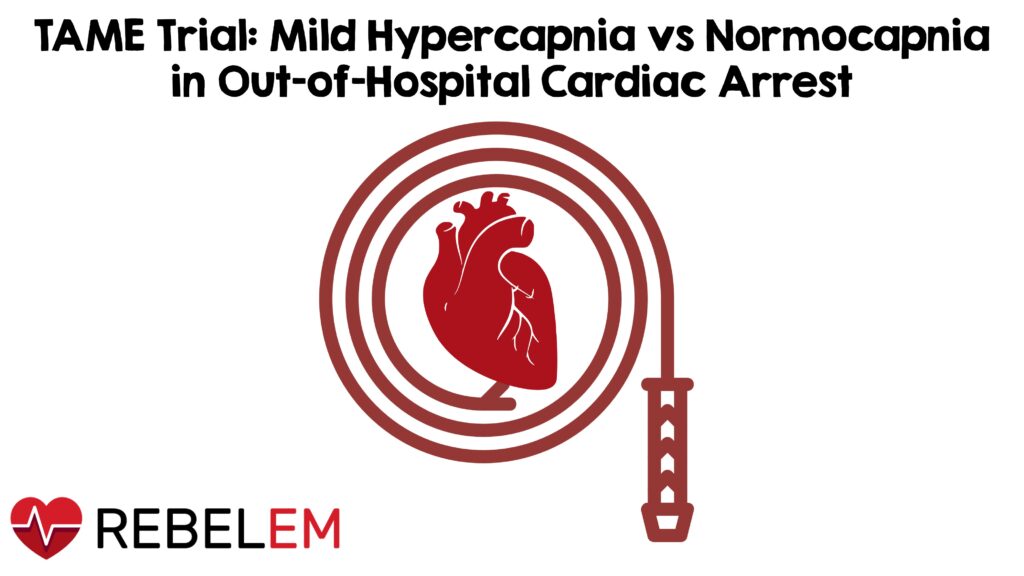Background Information:
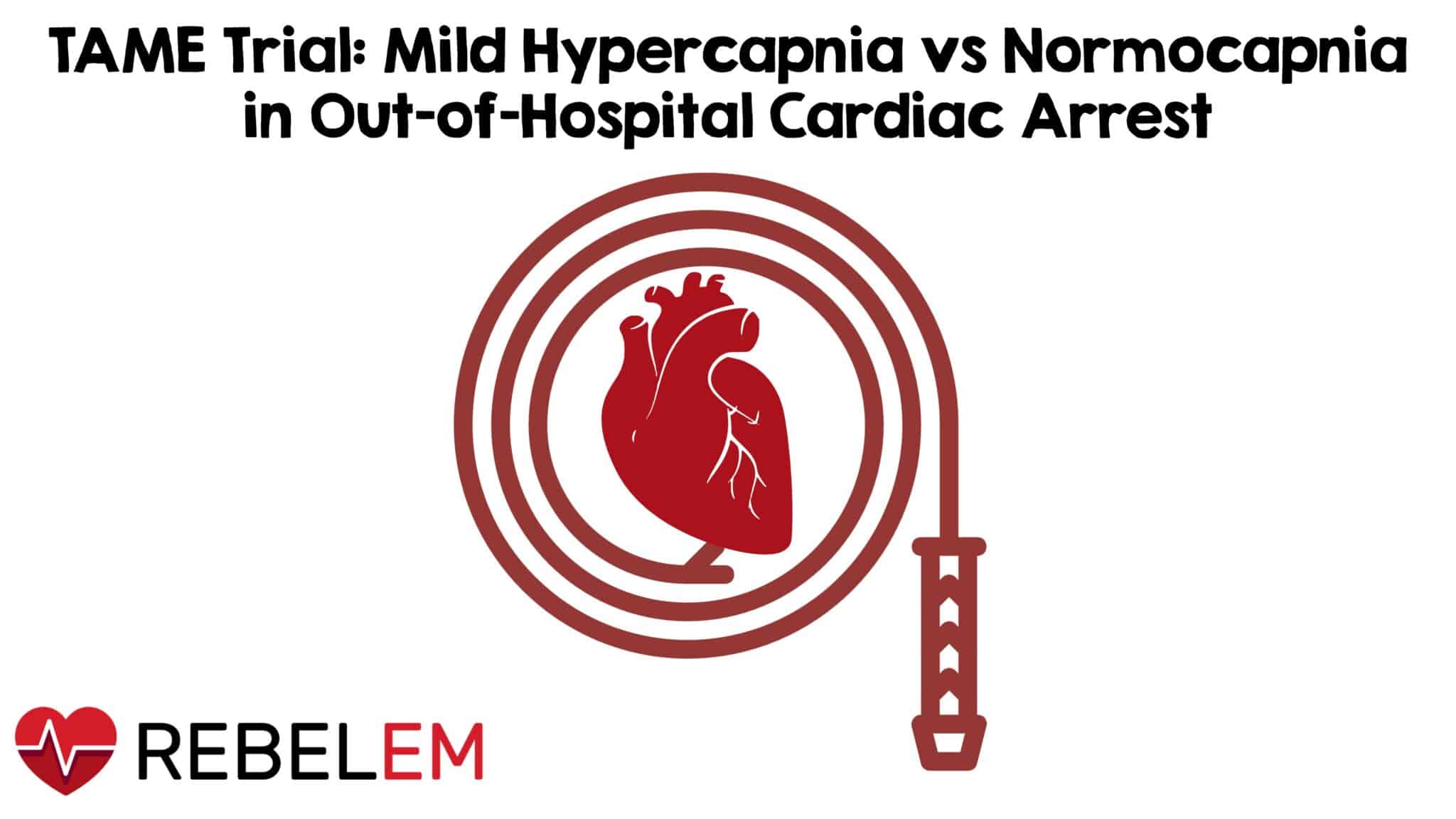
Paper: Eastwood G, et al. Mild Hypercapnia or Normocapnia after Out-of-Hospital Cardiac Arrest. N Engl J Med. Epub 2023 Jun 15. PMID: 37318140
Clinical Question:
- Does mild hypercapnia in adults with coma who have been resuscitated following out-of-hospital cardiac arrest provide favorable neurological outcomes in 6 months compared to normocapnia?
What They Did:
- The trial randomly assigned adults to the intensive care unit (ICU) after out-of-hospital cardiac arrest to to either 24 hours of mild hypercapnia or normocapnia
- This was a non-blinded, international, investigator-initiated open-label randomized trial
- The trail included in 1700 patients from 63 ICUs in 17 countries, with 850 patients assigned to each arm
- The 1700 participants were divided among the following two groups:
- Normocapnia or control group whose target PaCO2 was 35-45 mmHg
- Hypercapnia or experimental group whose target PaCO2 was 50-55 mmHg
- Attending clinicians were aware of the intervention assignment but statisticians, authors and assessors of prognosis and neurologic outcome were not aware of intervention assignments
- Protocol recommended a deep sedation target of a RASS score of -4 (on a scale from 4 being combative to -5 being unarousable), assessment of arterial blood gas every 4 hours and the use of end-tidal Co2 levels
- Ventilator settings, sedation and the use of paralyzing agents were at the discretion of the treating clinician
- Protocol-guided neurologic prognosis was assessed at 96 hours or later after randomization by a clinician who was again unaware of the intervention assignments
- Favorable neurologic outcome was assessed yet again at 6 months using validated scoring systems described further below
Inclusion Criteria:
- Adult (age ≥18 years or older)
- Out-of-hospital cardiac arrest of a presumed cardiac or unknown cause
- Sustained ROSC – defined as 20 minutes with signs of circulation without the need for chest compressions
- Unconscious (FOUR-score motor response of <4, not able to obey verbal commands after sustained ROSC)
- Eligible for intensive care without restrictions or limitations
- Within <180 minutes of ROSC

Exclusion Criteria:
- Unwitnessed cardiac arrest with an initial rhythm of asystole
- Temperature on admission <30oC
- On ECMO prior to ROSC
- Obvious or suspected pregnancy
- Intracranial bleeding
- Severe chronic obstructive pulmonary disorder (COPD) with long-term home oxygen therapy
Outcomes:
Primary
- Favorable neurologic outcome, defined as a Glasgow Outcome Scale– Extended (GOS-E) score of 5 to 8 at 6 months.
- A score of 5 refers to “Low Moderate Disability”; patients have some disability including hemiparesis, epilepsy, aphasia, or deficits in personality or memory but are able to look after themselves. These individuals are independent at home but dependent outside.
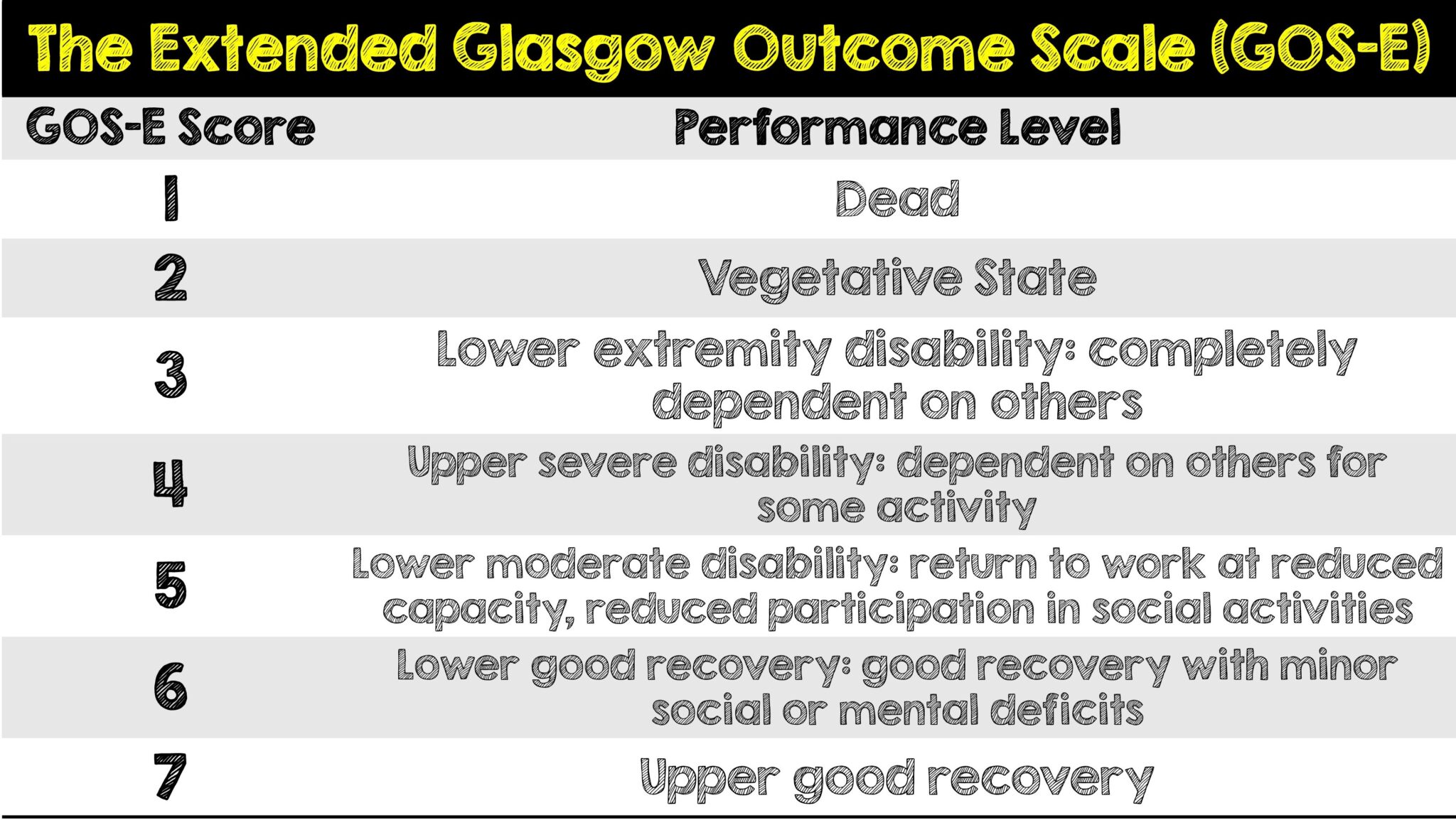
Secondary
- Modified Rankin Score
- Secondary outcomes included death within 6 months.
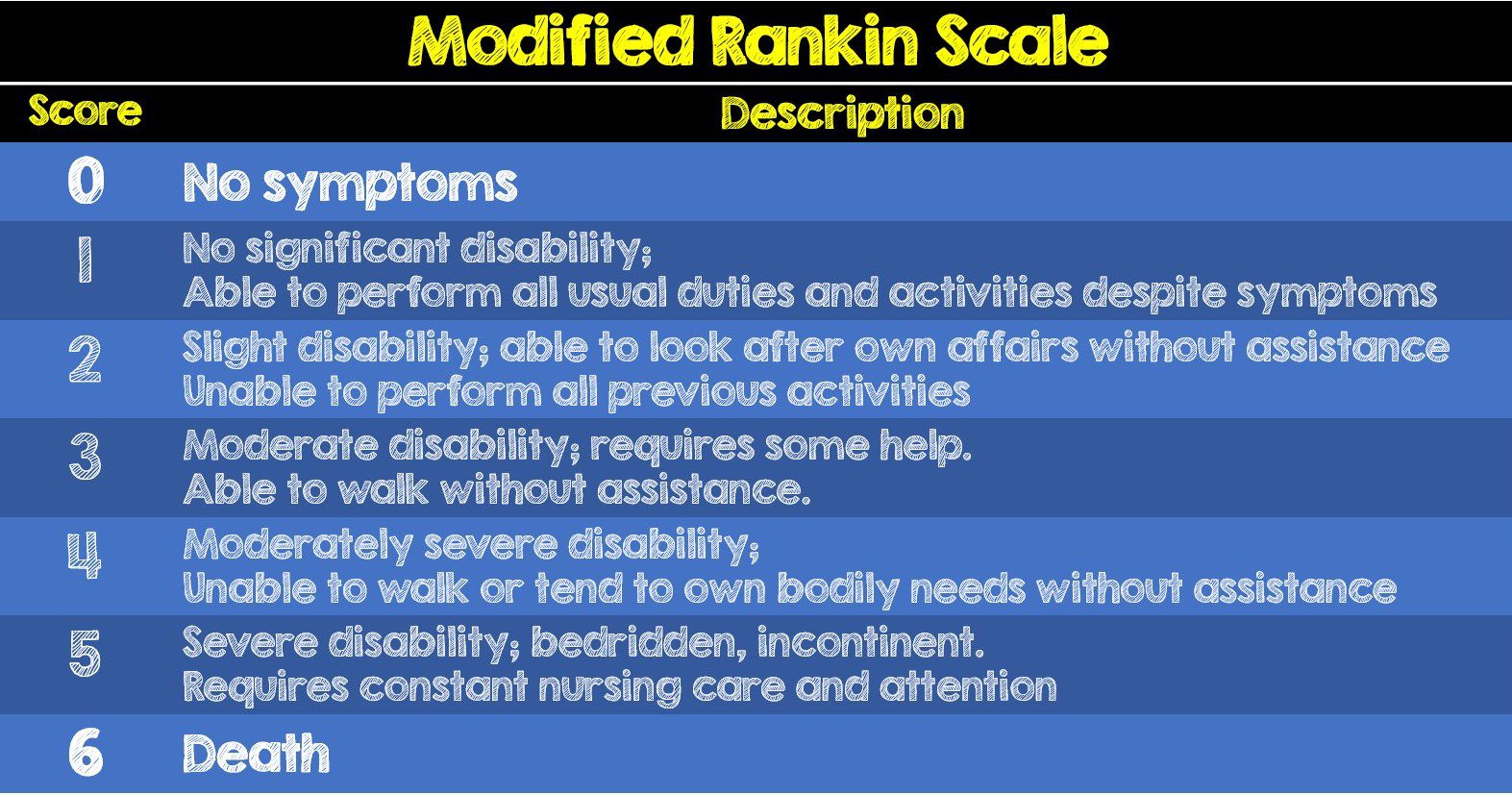
Results:
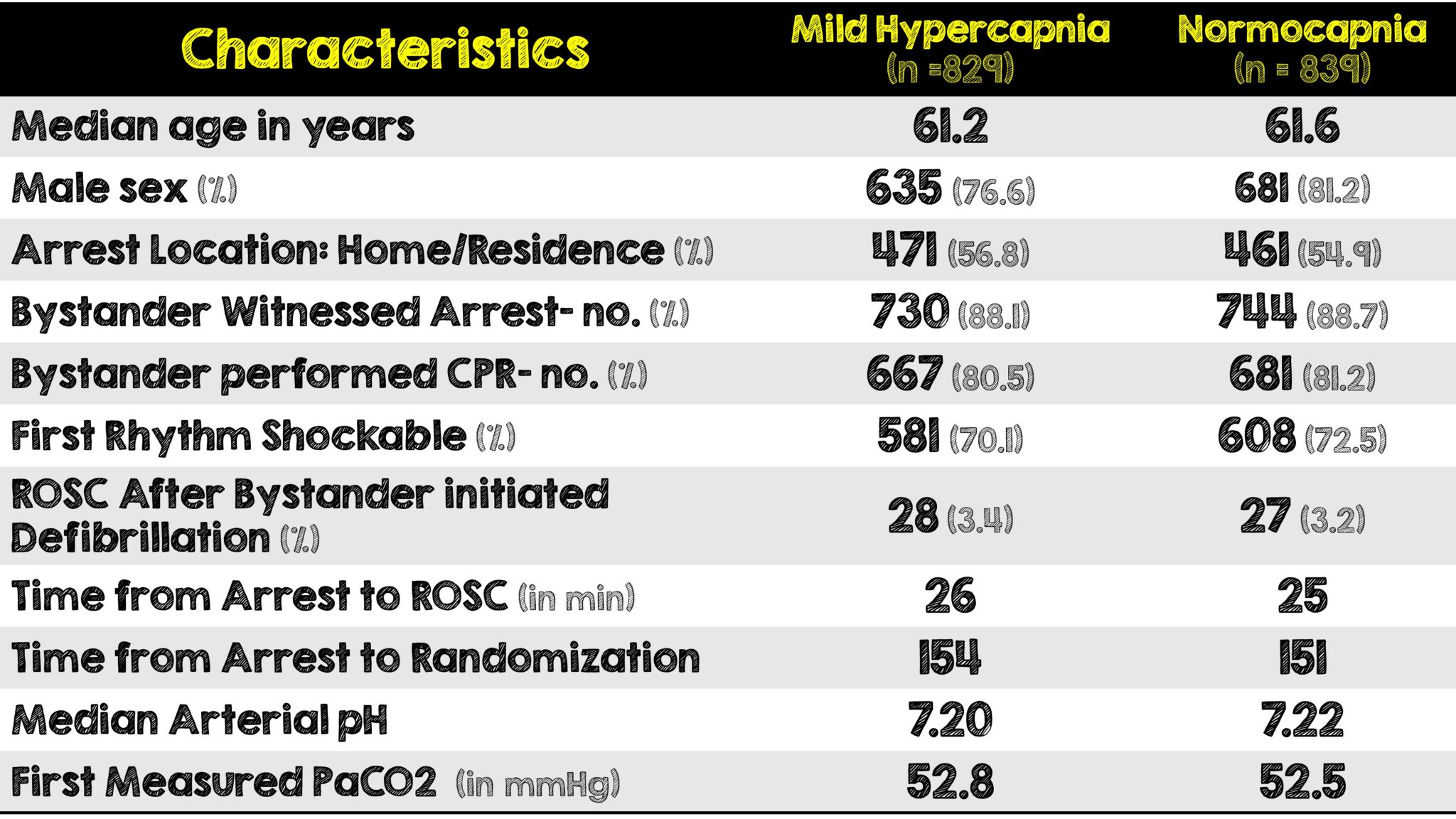
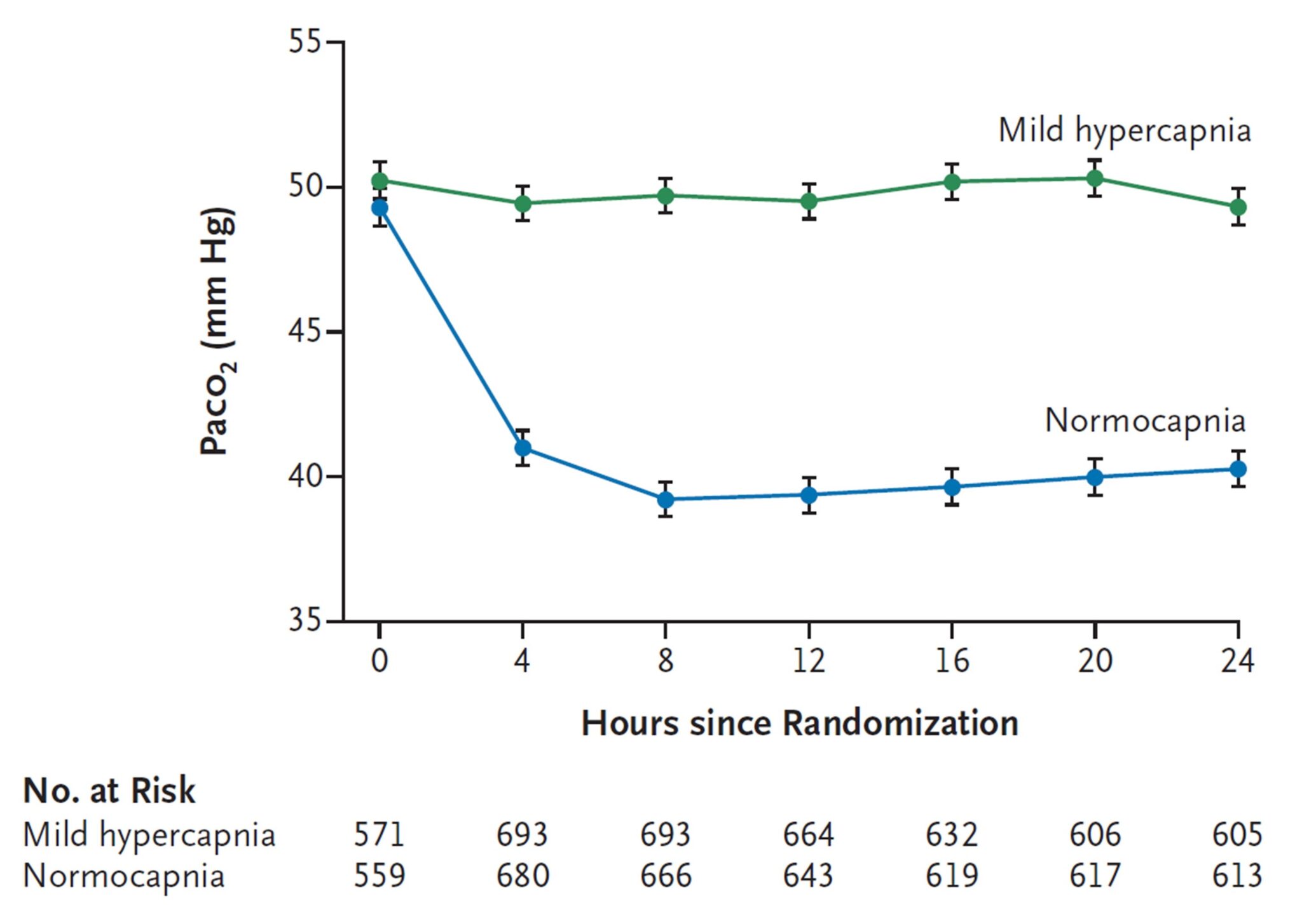
Figure 4: Partial Pressure of Arterial Carbon Dioxide during the 24-Hour Intervention Period (source: TAME Trial Paper)
- Authors were able to achieve separation of CO2 fairly quickly after randomization and then were able to sustain that separation for 24 hours.
Critical Results:
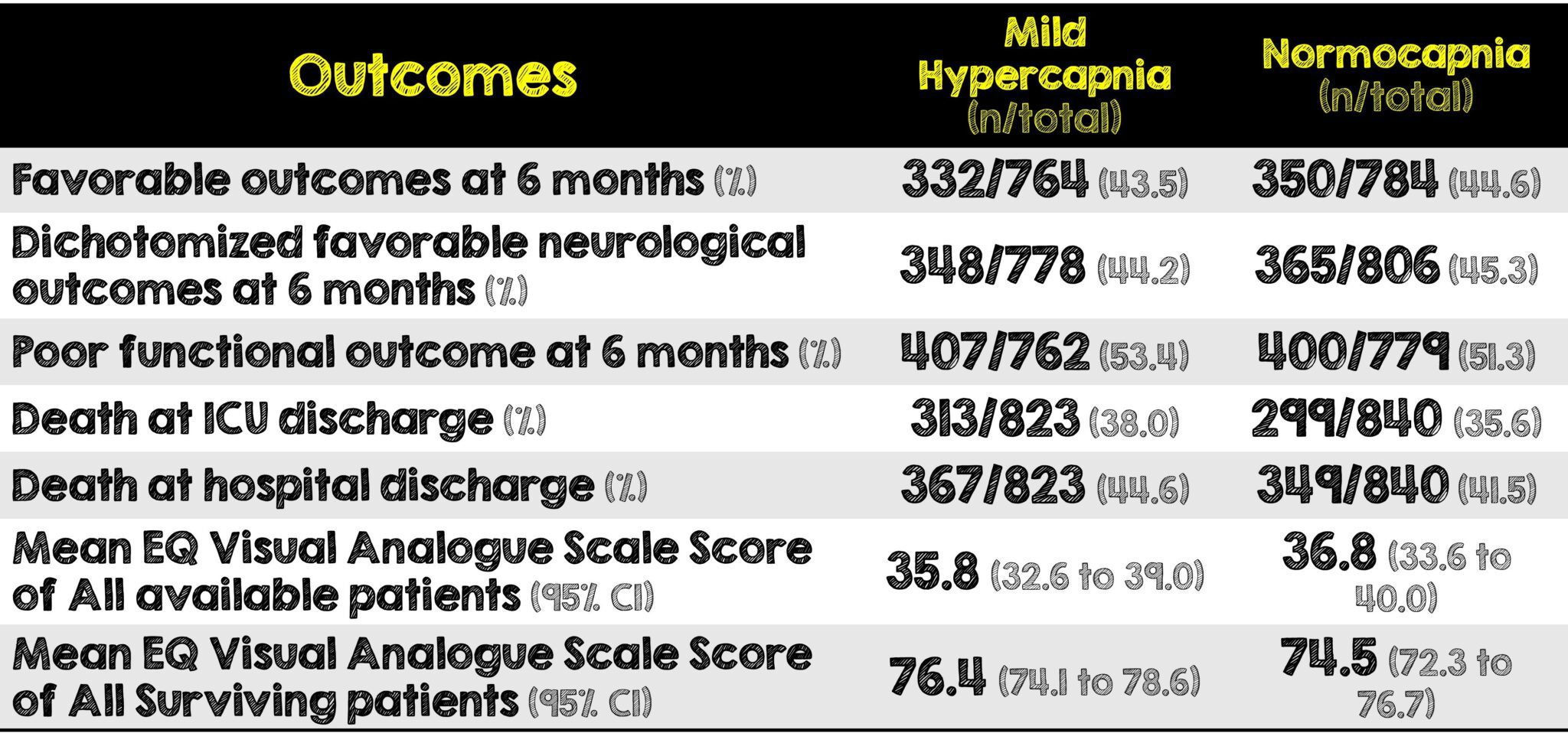
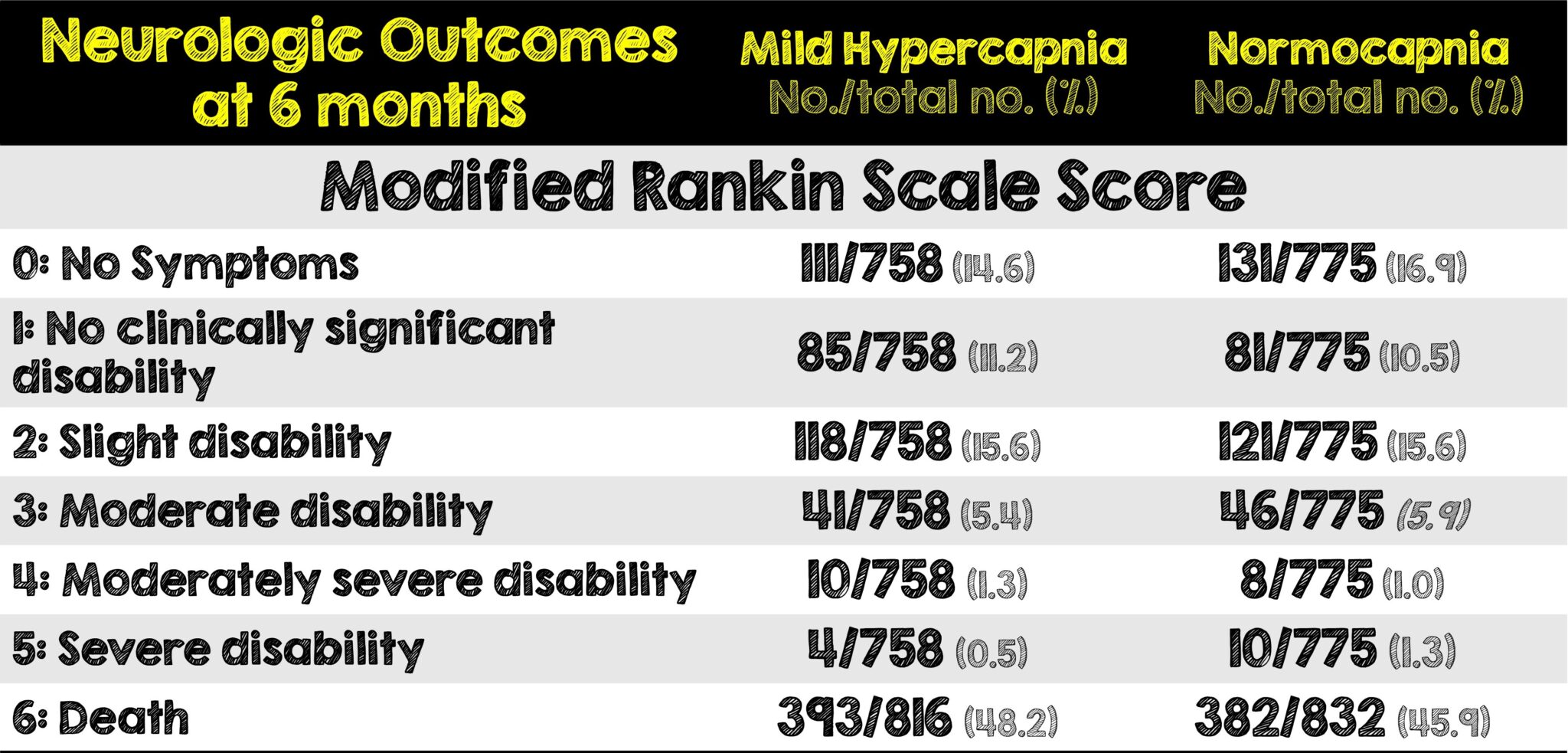
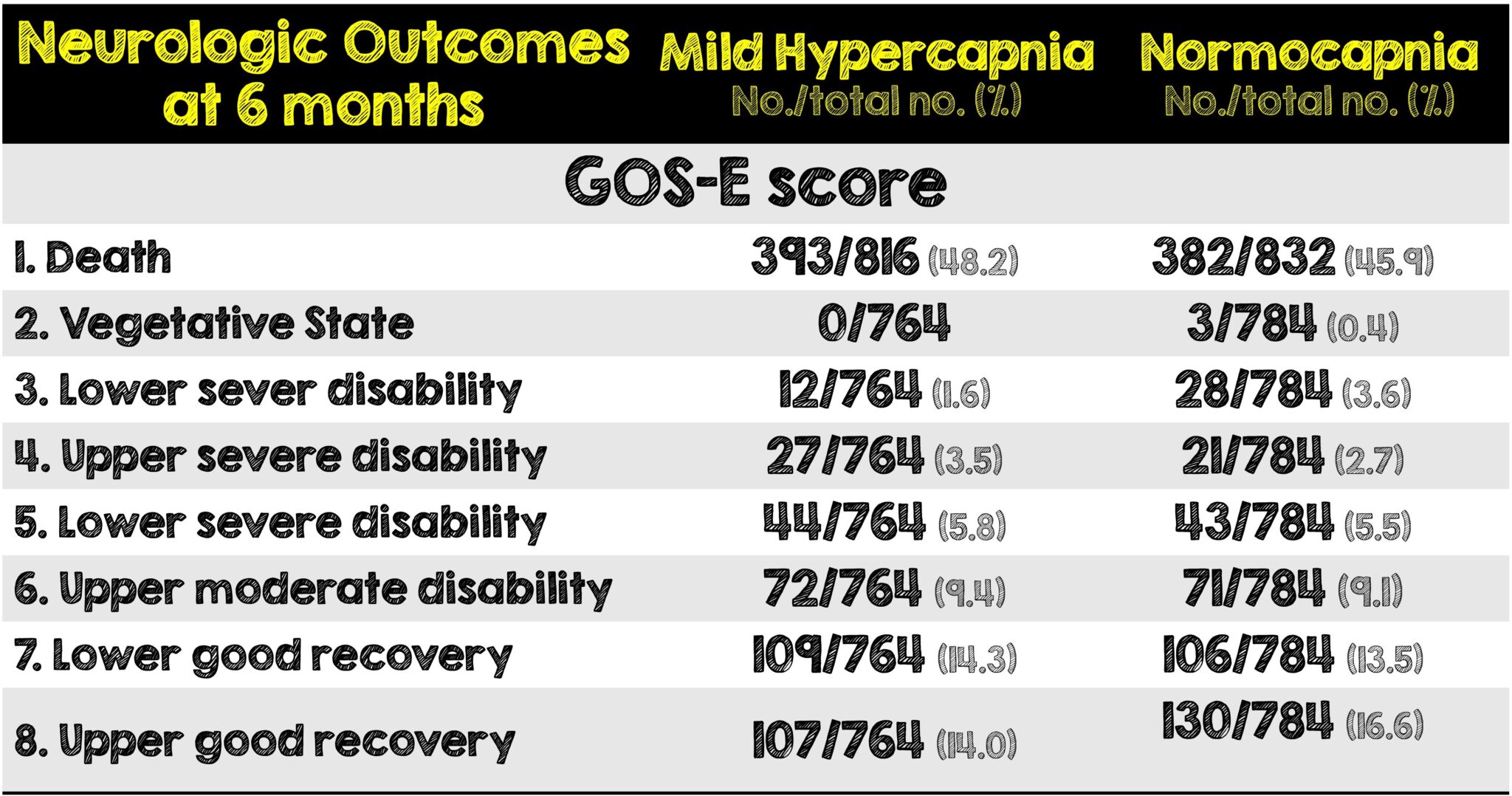
Strengths:
- The study was executed well with large sample size and power, which also accounted for factors such as loss to follow up and withdrawal of consent rate of 5%
- International multi-center study allows for great generalizability and more external validity
- An independent data and safety monitoring committee reviewed the data and performed one prespecified blinded interim analysis
- Well balanced control and experimental group
- Separation in mean PaCO2 values was achieved between the two groups in the intervention that the authors wanted to intervene on
- Protocol guided Neurologic assessment was performed at 96 hours by a blinded physician, statisticians and authors were also unaware of intervention assignments during data analysis
- Patient oriented primary outcome of neurologic function
- Well validated mRS used as a secondary outcome
- Evaluated patient perceived quality of life
- Outlined prespecified adverse events to look out for
Limitations:
- Co-enrollement in the TTM2 trial: the potential to have an interaction between the interventions
- Generalizability was very limited, the study did not investigate in-hospital cardiac arrest, with most patients having witnessed arrests with shockable rhythms and bystander resuscitation
- Generalizability may again be limited due to a very specific population: the majority of the patients included having had witnessed cardiac arrest with a shockable rhythm and bystander CPR.
- Selection bias is present in this study here because they utilized non-blinded enrollment by the clinicians
- Hypercapnia was common at randomization and may have attenuated the difference between the two groups
- Cerebral perfusion pressures were not routinely monitored and thus incidence of cerebral edema could have been higher
- There was missing data on approximately 8% of all patients in the study
- There was no form of follow up (in-person or over the phone) due to the COVID-19 pandemic
- Lots of clinical treatment variation as care between the two groups was left up to the provider
Discussion:
- The fact that cerebral pressures were not routinely monitored during the TAME trial is an essential consideration when interpreting the study’s results and generalizing them to real-world settings. Monitoring cerebral pressures is crucial in assessing the impact of interventions, especially in critical care scenarios. Without this data, it becomes challenging to fully understand the specific effects of pCO2 on brain pressures and its contribution to the overall outcomes of the trial
- Sample-size estimation was based on earlier trials of mild hypercapnia for cardiac arrest. Here the authors calculated an enrollment of 1624 patients would provide the trial with a 90% power to detect or reject a difference of 8% between a favorable neurologic outcome.
- Additionally, the TAME trial allowed a significant degree of discretion to the treating clinicians in managing the patients’ care. This flexibility may have influenced the outcomes and introduces the potential for confounding variables. The results may be influenced not only by the specific intervention (pCO2 management) but also by other aspects of critical care delivered during the trial.
- Given these limitations, it is crucial to interpret the study’s results in the context of its design and the resources available during the trial. While the trial provides valuable insights into the effects of pCO2 management, its real-world applicability, and the precise contribution of pCO2 to the outcomes may need further investigation in settings with different monitoring practices and variations in critical care delivery.
- It’s worth stating that the physiology in post-cardiac arrest is complex. It’s unlikely that one intervention or protocol will have a large benefit in outcomes across a heterogeneous population
- With the above said, while we have to be careful with algorithmic approaches to post-cardiac arrest care, this method is often needed to show a tested intervention works or doesn’t work. Initiating and maintaining multi-system bundled critical care treatments is resource extensive and demanding. It’s important to be able to initiate these treatments while also creating the opportunity to investigate possible therapeutic interventions for these patients within the confines of a well designed trial.
- The significance of the TAME Trial lies in its revelation that in certain situations, reducing intervention can lead to equivalent or superior results. The study’s primary focus was to assess the advantages of hypercapnia, but it unequivocally demonstrated that maintaining normocapnia in these patients is preferable.
- Lastly and arguably most important, the TAME Trial has brought attention to the notion that cardiac arrests should be viewed on a spectrum, and a one-size-fits-all approach may not be appropriate for every case, as outcomes can differ significantly. The trial’s diverse causes of cardiac arrests reaffirmed the necessity for individualized and customized care plans to address the unique needs of each patient.
Author’s Conclusions:
In patients with coma who were resuscitated after out-of-hospital cardiac arrest, targeted mild hypercapnia did not lead to better neurologic outcomes at 6 months than targeted normocapnia.
Our Conclusions:
The study’s methodology and limitations, such as the lack of routine cerebral pressure monitoring and the discretion given to clinicians, should be considered when interpreting the results. The trial’s algorithmic approach to post-arrest care also raises concerns about its feasibility and generalizability in real-world settings and instead highlights the importance of individualized care plans for cardiac arrest patients.
Clinical Bottom Line:
With achievement of separation between the two groups, the authors of this trial were able to successfully demonstrate that there appears to be no benefit (or harm) to targeting mild hypercapnia in a narrow population of post-cardiac arrest patients and that targeting normocapnia is sufficient for these patients. With that said, it’s important to note that narrow population consisted of patients who had a witnessed cardiac arrest with a shockable rhythm and bystander CPR performed. Thus the results of this trial may not be generalizable to unwitnessed cardiac arrest with non-shockable rhythms and/or a lack of bystander CPR.
Guest Post By:

Hrant Gevorgian, MD
PGY-3, Emergency Medicine Chief Resident
RWJBH Community Medical Center, Toms River, NJ
Twitter: Doc_HG

Emergency Medicine Attending and Cardiothoracic Intensivist
Clinical Assistant Professor of Emergency Medicine
RWJBH Community Medical Center, Toms River, NJ
Twitter: @MRamzyDO
Instagram: @MRamzyDO
REFERENCES:
- Eastwood G, et al. Mild Hypercapnia or Normocapnia after Out-of-Hospital Cardiac Arrest. N Engl J Med. Epub 2023 Jun 15. PMID: 37318140
- Mckenzie N, et al Arterial carbon dioxide tension has a nonlinear association with survival after out-of-hospital cardiac arrest: A multicentre observational study. Resuscitation. Epub 2021 Feb 8. PMID: 33571603
- Part 9: Post–cardiac arrest care | circulation – aha/ASA journals. (n.d.). https://www.ahajournals.org/doi/10.1161/circulationaha.110.971002
- Petran J, et al. Effects of hypercapnia versus NORMOCAPNIA during general anesthesia on outcomes: A systematic review and meta-analysis. Brazilian journal of anesthesiology (Elsevier). 2021 Feb 18. PMID: 35644204
- Zhou D, et al. Association between rate of change in PaCO2 and functional outcome for patients with hypercapnia after out-of-hospital cardiac arrest: Secondary analysis of a randomized clinical trial. The American journal of emergency medicine. Epub 2023 Jan 5. PMID: 36634567
For More Thoughts on This Topic Checkout:
- Critical Care Reviews: TAME Trial Results
- The Bottom Line: TAME Trial
Post Peer Reviewed By: Salim Rezaie, MD (Twitter: @Srrezaie)

